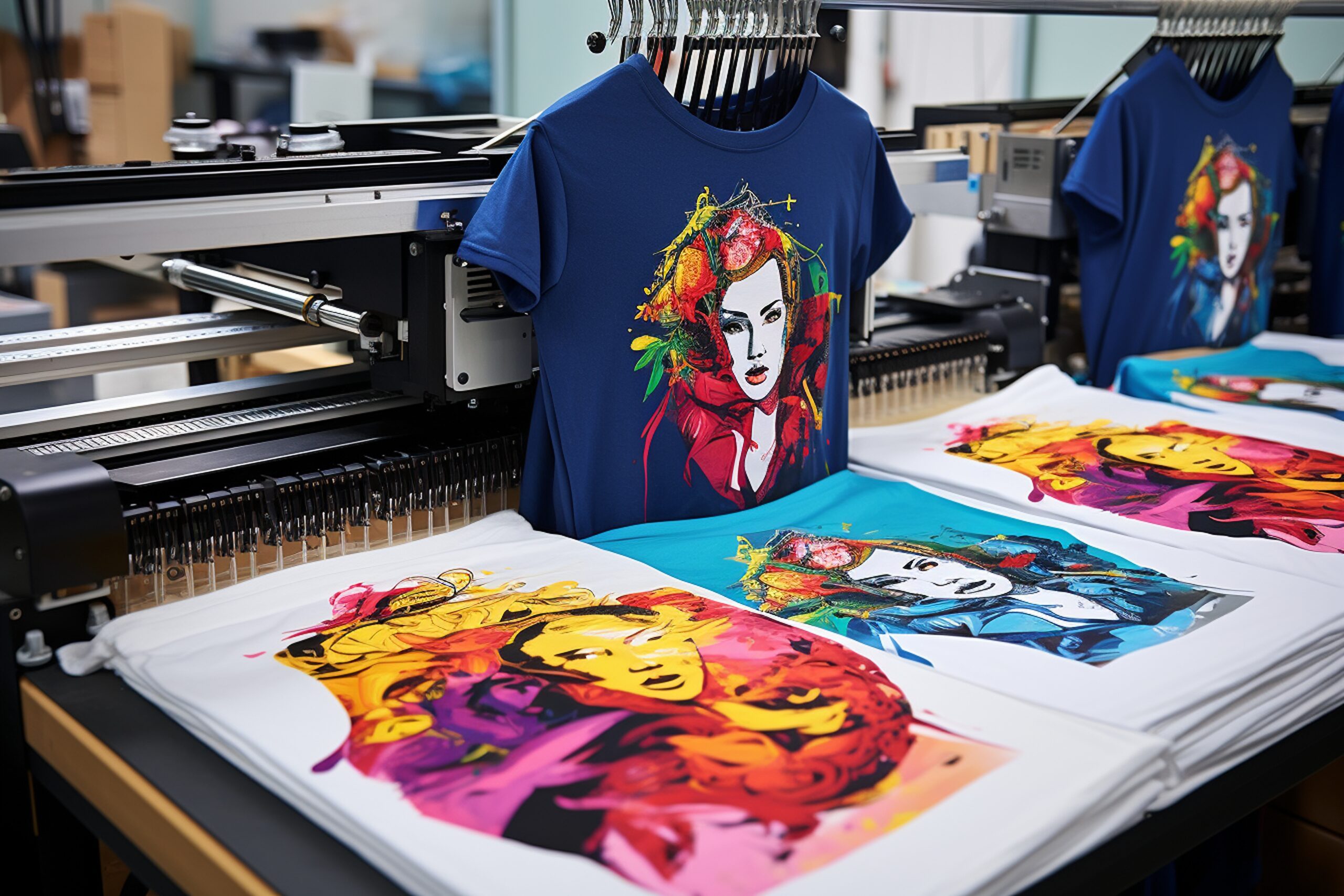AI is revolutionizing many industries, and the print-on-demand (POD) space is no exception. And to automate print on demand tasks, you can not only streamline your workflow but also free up time to focus on creative endeavors and strategic growth.
Here are the five most impactful ways to leverage AI in your POD business, leading to increased sales, saved time, and an enhanced customer experience. We’ll explore these methods in a step-by-step guide, so let’s dive in!
The first technique we’ll discuss is arguably the most crucial step to implement in your POD business. We’ll explore its advantages and how it can serve as the foundation for further automation strategies.
We strongly recommend that you check out our guide on how to take advantage of AI in today’s passive income economy.
Table of Contents
1. Idea Generation with AI
AI is an amazing way to get ideas for all kinds of different things in your business. The first way that you might use AI to get ideas is for what kind of business to start. We know we’re going to go into print on demand, but we might want to know what niches are best, or ideas for niches we could go into. We might want to ask for ideas for names or ideas for logos. There are many different things you could do in the idea space.
But let’s start by looking at ChatGPT and getting some ideas for a new business. We got ChatGPT up, and if we were starting completely from scratch, we might ask it something like, “I’m thinking of starting a print on demand business. What are the best niches to consider?” and let’s see what it does.
ChatGPT vs. Google Bard for Niche Ideas
ChatGPT gave us a bunch of different options here: #1 Personalized products, #2 Pet lovers, #3 Fitness and health, Hobbies and interests, and so on. I think we want to get a little more specific, so we might ask it a few more questions.
ChatGPT says outdoor activities, niche sports, crafting communities, and so on. It gave us a pretty exhaustive list here, and these are definitely more specific than we got in the beginning.
Now, I do want to mention that Google Bard is another option, very similar to ChatGPT. This is really Google’s answer, and I have found in using Google Bard that I like a lot of the answers a lot better. One of the reasons for that is because Google Bard actually has more up-to-date information. It’s trained on more current information.
When I went ahead and asked it, “How up-to-date is your information?” and then I asked it, “Are you trained on current information from 2024?” it did say yes. Now, it said that that information goes through a ton of filters and different things before it gets to Google Bard, so it may not be completely current. But you will likely be able to get pretty recent information in Google Bard as opposed to ChatGPT.
2. AI Art Generation for Print on Demand Designs
When you have a print on demand business, one of the biggest things is coming up with designs for your print on demand products. AI has taken so much time and effort out of doing that and made it so much easier to not only come up with high-converting designs but then be able to generate a ton of them in a very short amount of time.
What used to take us days or weeks or working with a graphic designer or trying to learn Photoshop and do it ourselves, we can now do it in seconds with AI art generators. I’ve talked about this a lot on my blog, and I’ll be sure to link some videos below.
But I just want to briefly show you some examples of that in my two favorite AI art generators, which are #1 Midjourney and #2, of course, Diffusion Bee, which is really great for t-shirts and print on demand.
Midjourney and Diffusion Bee for AI Art
Inside Midjourney, we’re over here in Discord, and these are just a few examples of some different designs I’ve done in here. These are specifically a game controller that we could add text to maybe in Canva or Photoshop and then upload that to our print on demand provider.
So, it’s able to generate really cool images like this. Here are a few other examples: if we go over here, we see some heart-shaped flowers, we see a guy in a suit swimming or scuba diving, there are all kinds of different stuff here, you see tigers.
These are just a few examples of what Midjourney can do. Most of the time with Midjourney, you’ll want to generate an image and then you might want to take it over to something like Canva, add your own text to it, and really just kind of finish out the design before taking it to your print on demand provider.
The other option that I love is called Diffusion Bee, and the main reason I love Diffusion Bee is because the designs definitely come out more print-ready for print on demand. And Diffusion Bee can handle text a little bit better than Midjourney can, as you can see here with the “Tiger Vibes” and “Make Dad’s Game Again” designs.
Other AI Art Generation Tools
Just a few examples here of what I’ve done in Diffusion Bee, and so I really like Diffusion Bee for that purpose: handling text, more print-ready designs that won’t need a lot of editing afterwards. Diffusion Bee can be a great tool.
A couple of other options you can check out for AI art generation: there is Adobe’s new art generation tool, there’s one called Leonardo, these are really great options, there are many others out there.
And in fact, I’ve even talked about in a recent article about Dolly being integrated into ChatGPT, so that now you can actually have a conversation with AI and have it make changes to the art right inside ChatGPT by using the Dolly app that you can just plug right into that.
So, it’s pretty incredible what we can do with AI art generators, and they are only getting better each and every day. And so I envision in the future, this is going to be an even easier process if you can believe it, once these continue to update and get better.
3. Automated Mockups with AI
The number three way to use AI in your print on demand business is also a really fun one, and it’s mockups. Gone are the days where you need to take photos of a customer wearing your product or even use tools like PlaceIt and actually finding mockups on the internet.
Now with AI, you can generate your own mockup that looks exactly like the customer that you are wanting to sell to. And again, this is reducing time, saving you money, and making this a much easier process.
You see over here in Midjourney just a couple of quick examples: these are actually models that are not real people that I have generated in Midjourney. And then what I can do is take these out again to a tool like Canva or maybe drop it in Photoshop and add my own design on the t-shirt.
And this gives me a 100% unique mockup that no one else has, that I can use for my brand to grow my sales, to promote on social media, maybe to run as an ad. And it just takes so much headache out of the mockup process.
4. AI for Writing Compelling Sales Copy
The number four way to use AI in your print on demand business is writing sales copy. This is something a lot of people struggle with: writing copy that actually converts. And when we use AI, we can actually tap into all of the data that it has on what actually works to have it write headlines for us and write even full ads, product descriptions, email marketing, social media posts, blog posts.
There are so many incredible ways to use this to write sales copy. So if we go over to ChatGPT, let’s ask it to write 10 Facebook ads about a t-shirt that says “Tiger Vibes Only.”
Okay, so we asked it to write us some ads, and we just used “Tiger Vibes Only” because we just looked at that in our Diffusion Bee account. And you can see here that it’s going to write “Plus Facebook ads,” so it’s going to give us a few different things here.
Now, this was a very simple prompt, and this may not be exactly what you want, so we can get a little more detailed. We can ask it to say it in a different way, we can ask it to say it with a different tone, and we’ll get a better result.
Refining AI-Generated Copy for Optimal Results
Okay, so it’s given us 10 here, and we could read through some of these. This will definitely give us some good ideas, even if we don’t use these exactly as they are.
But we can also get a little more specific. So we can say, “Give me five headlines for this t-shirt.” Okay, and then it will pop out some actual maybe just headlines or hooks that we might want to use.
So this right here might be a little more useful: “Unleash Your Wild Side with our Tiger Vibes Only Tees,” “Roar in Style, Get Your Exclusive Tiger Vibes Only,” and so on. Now, this is helping us maybe write a little more compelling headline.
Now what we could also say is we could tell it to change the tone, maybe say it in a more fun way. “Can you say these in a more fun way?” Okay, so we asked it that, it’s going to make it a little more fun, a little more playful, right?
So it’s going to, it says specifically, it’s going to add a bit more fun and excitement to these headlines. “Roar Louder Than Ever, Grab Your Tiger Vibes Only Tee and Pounce into Style,” okay? We’re getting pretty creative, and these are a lot better than what we originally got, which sounded more robotic, right?
So this is an example of how you shouldn’t just put in a prompt when you want sales copy. You shouldn’t just say, “Write an email for this.” Maybe you could start with that, but then you want to caress it a little bit, you want to finesse it a little bit, add some additional follow-up questions to get closer to what you are looking for. This is the best way to use AI for these kinds of things because they’re not initially going to know exactly what you want, and you don’t usually want this robotic sales copy. So you’re going to have to work with it a little bit.
AI Copywriting Tools Beyond ChatGPT
One other quick thing I want to make you aware of here is that there are other software and tools that are not ChatGPT that are specifically for writing copy with AI. One of those examples is this company called Jasper.
Now, why would Jasper be useful? Well, again, Jasper is trained specifically to write marketing copy, so it’s going to do a little bit better job. And it’s also going to help you edit it much easier. It’s just going to be a full-fledged suite to write your sales copy and to use AI to get ideas and to also just write a little bit better, high-converting sales copy than you might get out of ChatGPT.
There are many other softwares that do this as well. I’m not promoting Jasper because there are other options. This is just one example, probably the most well-known example of a software that does something like this.
So whether using ChatGPT or using something like Jasper, you should definitely be starting to use these tools, using AI to write sales copy for ads, emails, social media posts, product descriptions, blogs, anywhere that you need these kinds of things, even YouTube descriptions. There are so many ways that you can use AI to write copy.
5. Enhancing Customer Experience to Automate Print On Demand Sales
Number five is enhancing the customer experience and growing your sales. Okay, so this is definitely probably one of the last things you want to look at when you’re really starting to integrate AI into your e-commerce business or print on demand. This might not be the thing you want to do right away. It might not be the most obvious.
But what I want to show you is two Shopify apps that you can plug right into your store that are going to create a better experience for your customers, handle some of your customer service, and also help you increase sales. Again, I’m not promoting either one of these apps. These are just examples of one of the options that you could use. There are many other options to do these things out there in the Shopify App Store.
If we go over to the App Store and we look at this app called Tio, now Tio is a live chat and an AI chatbot, and it does a bunch of different things. So one of the things it’s going to do is it’s going to provide a little chat box there that will handle some of your customer service on your Shopify store.
Another thing that it will do is it will recommend products inside of a chatbot that may help your customer make a purchase, helping you automate print on demand and increase sales.
Using AI Chatbots to Drive Sales
What’s cool about this is when you use an AI tool like this, an AI chatbot, it’s going to be able to pull data from all of the stores that it is integrated in. It’s going to be able to use that data and interpret it to actually make better, sounder decisions for your store to actually increase your sales.
Okay, so imagine that a customer comes to your website, they’re shopping around, but they can’t find what they’re looking for, and then they can go, they click on the little chatbot, and they just ask it directly for what they’re looking for, and it can send them directly to that page or provide a link or maybe even allow them to add that item to cart right from the chat without even going to the page, right?
Those are just a few examples. A few other examples of how it might be able to help you with customer service, and something specifically that Tio does, is it’s able to answer questions that your customers might have about existing orders or their cart.
So they might come in and might say, you know, “I can’t find the tracking information for my order,” and the AI chatbot could ask for their name and information, and they can provide it. It can provide your customer with that information. It can check order history, recommend products, preview their cart. I mean, all kinds of different things that it can do.
Your customer might want to go into the chatbot and say, “What is your return policy?” instead of going to the return policy on your website, or maybe they can’t find it. The chatbot can just give them the return policy right there in the chat.
So this is pretty cool. Another app that you can use specifically to automate print on demand and increase sales is called Wiser: Post Purchase Upsell. So again, this kind of app can use all of the data that it is trained on, both from your store and other stores, and just whatever it is trained on, to actually make a better decision and recommend a product as an upsell that will hopefully grip your customer and make them pull out their credit card, right?
As opposed to just recommending a random product or choosing a product, it can make a better decision on what products to recommend as an upsell for your customer, and there are many other upsell apps in the Shopify App Store that use AI to recommend products in a better way and hopefully increase conversions, make more sales, increase that AOV for you and your business.
I hope you can see the incredible ways that you can use AI in your print on demand business to automate print on demand, save tons of time, save tons of money, and make you more money. So thanks again for reading, and we’ll see you next week!
Automate Print-on-Demand T-Shirt Business FAQs:
Thinking about starting a print-on-demand t-shirt business? Automating several aspects of this business model can free up your time and streamline your workflow. Here are some of the most frequently asked questions about automating a print-on-demand t-shirt business:
What do I need to know about print-on-demand?
Print-on-demand (POD) is a fulfillment method where you don’t hold any physical inventory. You design the t-shirt, and the POD service provider prints and ships the shirt directly to the customer after they order it. This eliminates the upfront costs of buying t-shirts in bulk and the hassle of managing your own inventory and fulfillment. However, automating certain tasks within a POD business can make it even more efficient.
Here are some key things to know about POD:
- Costs: POD services typically charge a per-item printing fee. This fee varies depending on the service provider, the type of t-shirt, and the number of colors in your design. There are usually no monthly fees involved.
- Design Ownership: You retain full ownership of your designs when using a POD service.
- Profit Margins: Your profit margin is the difference between the selling price of your t-shirt and the printing fee charged by the POD service.
- Marketing: You are responsible for marketing your t-shirts and driving traffic to your online store.
How many t-shirt designs should I start with when automating a print-on-demand business?
There’s no magic number when it comes to how many designs to start with. You can begin with a few strong designs to test the market and see what resonates with your target audience. As you gain experience and data, you can expand your collection and explore new design ideas.
Here are some things to consider:
- Quality over quantity: Focus on creating high-quality designs that you’re proud of.
- Variety: Offer a variety of designs to cater to different tastes and styles.
- Targeted designs: Consider creating designs that target specific niches or interests.
Is a print-on-demand t-shirt business profitable?
The profitability of a print-on-demand t-shirt business depends on several factors, including:
- Product pricing: Setting a competitive price point that allows for a healthy profit margin.
- Marketing efforts: Effectively driving traffic to your online store.
- Design popularity: Creating designs that people want to buy.
- POD service fees: Choosing a POD service with reasonable printing fees.
How can I automate a print-on-demand t-shirt business?
By leveraging automate print on demand tools and services, you can streamline tasks like order fulfillment, customer service, and marketing. This allows you to focus on the creative aspects of your business, such as designing new t-shirts and growing your brand.sharemore_vert

We strongly recommend that you check out our guide on how to take advantage of AI in today’s passive income economy.




